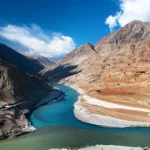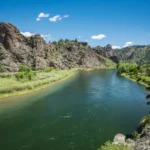
Death Valley is a desert near Nevada and the California border and is the hottest, driest, and lowest region in North America. Death Valley has been home to the Native American people for at least 1,000 years, originally known as the Panamint Shoshone but now known as the Timbisha. However, artifacts dating back 9,000 years have been found proving that people were there long before the Panamint Shoshone. Death Valley was named after gold prospectors during the California gold rush in 1849 after several pioneers died during an expedition. On November 11, 1933, US President Herbert Hoover declared a large part of the Death Valley area to be the Death Valley National Monument and placed the region under federal protection. It became Death Valley National Park in 1994 and was expanded to include the Eureka and Saline valleys.
Here are some of the most interesting Death Valley Facts:
Death Valley National Park is 3.4 million acres and the largest national park in the U.S.
In July 2018, Death Valley experienced its hottest month on record. The average temperature was 108.1⁰F including overnight lows. Daytime highs reached a temperature of 127⁰F for four days in a row.
Death Valley is located in the Mojave Desert.
The climate of Death Valley is created because of the mountains on all sides which trap dry, hot air masses.
The Park is home to more than 1000 species of plants (including 50 that are found nowhere else in the world).
On July 10th, 1913 the temperature at Greenland Ranch (formerly Furnace Creek) in Death Valley was recorded at 134° Fahrenheit. This is considered to be the highest ambient air temperature ever recorded on the earth’s surface.
The Park is home to more than 51 species of mammals (including bighorn sheep and mountain lions).
Despite its hot and dry climate Death Valley is home to a diverse range of fauna (which grows after it rains), more than 300 bird species, as well as many different species of lizards, snakes, reptiles, amphibians and even bighorn sheep and mountain lions.
Death Valley is home to 36 species of reptiles and a handful of amphibian and fish species.
Death Valley has been a popular shooting location for the Star Wars movies.
There is a crater in Death Valley called Ubehebe Crater. It is 500 to 777 feet deep and half a mile wide, and despite previous research that dated the crater to up to 7000 years old, current research suggests it is only 800 years old.
Archaeologists have found evidence of the human presence in Death Valley that dates back at least 9,000 years!
Death Valley is considered to be the driest region in the United States. There was no rain recorded there in 1929 at all!
The lowest point in the United States is Badwater Basin, located in Death Valley. It is 282 feet below sea level.
The Timbisha Shoshone Native American Tribe has inhabited Death Valley for the past 1,000 years.
The highest point in the United States in at Mt. Whitney, at 14,505 feet. Death Valley, which has the lowest point in the U.S., is only 76 miles from Mt. Whitney.
The lowest golf course in the world is located in Death Valley. The Furnace Creek Golf Course, with 18 holes, sits 214 below sea level. It is not as popular with golfers during Death Valley’s hottest summer days. In August the average temperature is 113.9°F.
People from the Saratoga Spring Culture left some of the area’s earliest recorded art on the canyon walls.
February tends to be the wettest month in Death Valley, with an average of 0.51 inches of rain.
Joshua Trees and Bristlecone Pines can be found in some of Death Valley’s higher areas, but most of the vegetation growing in the region consists of low lying shrubs.
In mid-2004 to mid-2005 Death Valley received more rain than usual and wildflowers bloomed more than usual.
In January 1922 some snow accumulation was recorded but usually the only sign of snow in the region are scattered flakes.









